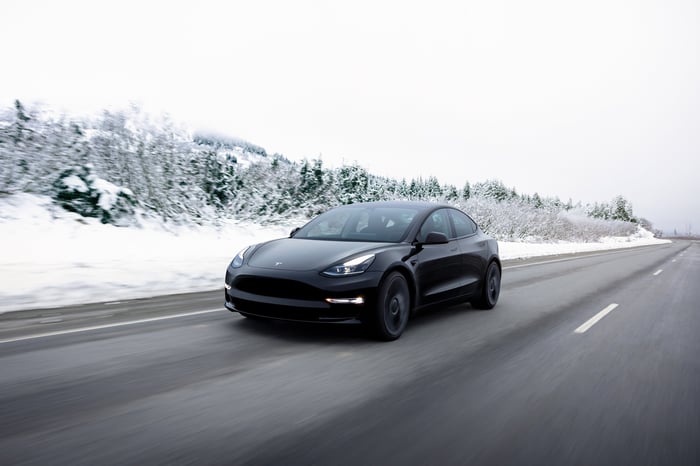Tesla Faces Challenges Amid Declining EV Sales and High Valuation
Tesla (NASDAQ: TSLA) experienced a 63% stock surge by the end of 2024, largely attributed to President Donald Trump’s election victory in November. Investors speculated that Trump’s administration could foster a more favorable regulatory environment. This speculation stems partly from CEO Elon Musk’s close relationship with Trump, suggesting a potential acceleration in Tesla’s autonomous driving and humanoid robotics initiatives.
Musk envisions these innovations could someday position Tesla as the most valuable company globally. He even posits that Tesla might surpass the market valuations of the next five largest firms combined—currently Apple, Microsoft, Nvidia, Amazon, and Alphabet—worth a total of $12.9 trillion.
Start Your Mornings Smarter! Each market day, receive Breakfast news in your inbox. Sign Up For Free »
However, a significant concern has emerged, leading to a 41% decline in Tesla stock since its December peak. The company is grappling with a noticeable drop in electric vehicle (EV) sales, which remain its primary revenue source. This article explores why Tesla stock may face more downward pressure contrary to Musk’s bullish forecasts.

Image source: Tesla.
Tesla’s First Quarter Delivers Disappointing Numbers
Once the world leader in EV sales, Tesla has lost its crown to China-based BYD, which delivered more vehicles in the past two quarters. Consumers are increasingly favoring budget-friendly options like BYD’s Seagull EV, priced at just $10,000 domestically, and expanding into international markets, including Europe. Tesla struggles to compete at this price level.
The emergence of other EV manufacturers is only part of Tesla’s challenges. The company’s brand appeal seems to be eroding on its own, as indicated by stagnant growth in 2024. Tesla delivered 1.79 million vehicles in 2024, reflecting a 1% decrease from the previous year. This outcome contrasts sharply with Musk’s previous commitment to expanding production by 50% annually, a target now looking unattainable without higher sales.
This year could prove even tougher. Tesla announced deliveries of 336,681 EVs for Q1 (ending March 31), a substantial 13% drop from the same period last year. This figure also fell short of Wall Street’s revised average forecast of 377,590 units, raising new alarms among investors.
Musk’s increasing involvement in global politics may be contributing to the sales slump. Reports indicate rising incidents of violence against Tesla dealerships and vehicles, not only in the U.S. but also across Europe. His role with the Department of Government Efficiency—focused on curtailing “wasteful” spending—has also polarized public opinion.
Beyond EVs: Exploring Tesla’s Future Opportunities
As of now, Tesla holds a market cap of $886 billion, which is three times that of Toyota, despite selling 83% fewer vehicles last year. Tesla’s current valuation appears detached from the realities of its EV business; instead, investors are banking on a slew of forthcoming products that have yet to materialize.
Among these innovations is the Cybercab, intended to run on Tesla’s full self-driving (FSD) software. The plan is to create a ride-hailing network with autonomous taxis that can transport passengers and generate revenue continuously, paralleling Uber but without human drivers. While the FSD software isn’t approved for unsupervised operation on U.S. roads, Musk is optimistic about deploying it in Texas and California later this year.
Wall Street has high expectations for the Cybercab. Dan Ives from Wedbush Securities sees autonomous vehicles as a trillion-dollar market for Tesla, while Cathie Wood’s Ark Investment Management predicts that the autonomous ride-hailing sector could catapult Tesla to an $8 trillion valuation by 2029.
Musk looks toward an even larger horizon with humanoid robots. He predicts that by 2040, robots will outnumber humans as they take over repetitive, dangerous, and household tasks. Tesla plans to manufacture several thousand Optimus humanoid robots in 2025, with aspirations for annual production to reach 100 million in subsequent years. Although the pace of demand growth remains uncertain, Musk has projected that Optimus could generate a staggering $10 trillion in revenue over time.
Potential for Further Declines in Tesla Stock
Despite the promising long-term outlook for Tesla, the company’s sales performance poses significant risks. Currently, EV sales comprise 79% of its total revenue, so declining sales will negatively impact financial results. Tesla’s earnings per share (EPS) for 2024 fell 53% to $2.04, reflecting challenges associated with reduced EV sales. If delivery figures do not improve in 2025, the financial knock-on effects could be severe.
With a striking price-to-earnings (P/E) ratio of 130.9, Tesla stock currently trades at four times the valuation of the Nasdaq-100 index, which averages a P/E of just 29.2. Comparatively, Tesla’s valuation far exceeds that of peers like Apple, Microsoft, Nvidia, Amazon, and Alphabet.

TSLA PE Ratio data by YCharts.
For Tesla to achieve a value greater than all five major companies combined, as Musk predicts, its stock would need to increase by 1,350% from current levels. Given the current P/E ratio and the trajectory of its EPS, such a leap seems highly improbable, especially if declining EV sales continue.
With products like the Cybercab and Optimus still on the horizon, Tesla must navigate its current challenges to stabilize EV sales.
Tesla Faces Significant Challenges Amidst Predictions of Stock Decline
Tesla currently finds itself amid substantial challenges that could hamper its performance over the next couple of years. The company is grappling with various issues, including brand damage and increased competition, which may delay its ability to recover and improve its standing in the electric vehicle (EV) market.
Furthermore, it seems unlikely that Tesla’s upcoming product launches will arrive quickly enough to rejuvenate its struggling EV business. As a result, I anticipate that its stock could face a significant drop from current levels. To align with the Price-to-Earnings (P/E) ratio of Nvidia—one of the fastest-growing companies globally—Tesla’s stock would need to fall by 73%. Additionally, a decline of 78% would be necessary for Tesla to match the P/E ratio of the broader Nasdaq-100. These scenarios could become relevant within the next year.
Investing Insights: A Second Chance at High-Value Opportunities
If you ever felt left out from purchasing some of the most prosperous stocks in the market, this is an opportunity you will want to consider.
Occasionally, our expert analysis team provides a “Double Down” stock recommendation for firms they assess are on the brink of significant growth. If you’re concerned that you’ve missed your chance to invest, now might be the best time to act before it slips away. The performance numbers are compelling:
- Nvidia: An investment of $1,000 when we recommended doubling down in 2009 would now be worth $244,570!*
- Apple: If you invested $1,000 during our 2008 double down, it would have grown to $35,715!*
- Netflix: A $1,000 investment following our 2004 recommendation could be worth $461,558!*
Currently, we are issuing “Double Down” alerts for three remarkable companies, and another opportunity like this may not arise in the near future.
Continue »
*Stock Advisor returns as of April 5, 2025
Suzanne Frey, an executive at Alphabet, is part of The Motley Fool’s board of directors. John Mackey, former CEO of Whole Foods Market, an Amazon subsidiary, also serves on the board. Anthony Di Pizio holds long positions in April 2025 $200 puts and April 2025 $210 puts on Tesla. The Motley Fool has positions in and recommends Alphabet, Amazon, Apple, Microsoft, Nvidia, Tesla, and Uber Technologies. The Motley Fool recommends BYD Company and has issued long January 2026 $395 calls, along with short January 2026 $405 calls on Microsoft. Please review The Motley Fool’s disclosure policy for more information.
The views and opinions expressed herein are solely those of the author and do not necessarily reflect the opinions of Nasdaq, Inc.


